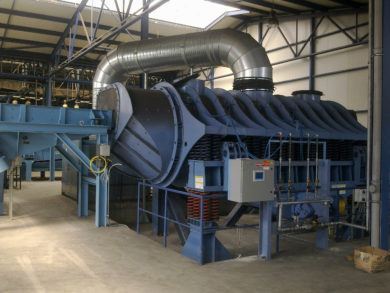Don’t miss: Foundry Safety Part 1: Noise Control
The next subject in our foundry safety discussion is Dust control. A serious issue surrounding the safety of your employees, Crystalline Silica dust or silica as it is most commonly referred to, is fine granite particles caused by grinding, crushing, and other manufacturing processes. This fine dust becomes a health hazard when it enters the air and is inhaled into the lungs.
Permissible Exposure Limit
Silica can be a much greater health risk to foundry employees than most would think. In fact, OSHA has moved the permissible exposure limit (or PEL) to 50 μg/m3 over an 8-hour workday for just this reason. Prolonged exposure to silica dust can have damaging effects on the human body. Silica dust, when breathed into the lungs, causes scarring to form thus blocking the absorption of oxygen causing other problems such as silicosis, lung cancer, kidney disease, and chronic obstructive pulmonary disease.
The PEL determined by OSHA is a level nearly undetectable by modern sensors. If the dust is not visible it may still surpass the limit. It is always a good idea to test your environment to be sure it meets OSHA standards.
Make sure your foundry is informed. Download the Silica Safety Infographic: Silica Safety Infographic (Download)
Why Silica Dust is Airborne
Silica becomes a health hazard when it enters the air we breathe. Silica dust can become airborne for a variety of reasons. The first reason is an abundant one in the foundry: Heat. Heat goes hand in hand when it comes to the foundry environment. (In fact, it is the focus of GK’s Foundry Safety Part 3 due to the variety of issues heat may cause.) Heat causes the warm sand and silica dust to rise into the air where it then can be inhaled. The second issue causing silica dust to fill the air is movement. Movement of equipment and transferring sand from unit to unit causes dust to be kicked up into the air and allows air currents to keep the particles airborne.
How to Control Dust in your Facility
Controlling dust in your Foundry can be done in many ways similar to those for noise control.
Here are a few things we recommend to our customers to reduce silica dust in the foundry:
1.)Ventilator suits- quarantining the air your operator’s breath from the contaminated air in your facility is the quickest and simplest way to ensure they are in a healthy environment. However, the biggest aversion to suits is they can be uncomfortable and hard to work in.
2.)Manipulators- similar to ventilator suits, removing your employees from a hazard is the best way to keep them safe. However, manipulators can slow down your process and negate precision work.
3.)Shakeout Enclosures- a great way to keep silica contained while going through a process that can kick up a lot of dust. Unfortunately, enclosures often cause blind spots and can make equipment harder to observe and maintain.
4.)Shot Blast- remove the sand before it comes in contact with people. It can, unfortunately, be an expensive process and introduces shot to the rest of your system.
5.)VIBRA-DRUM® Casting Conditioner– cools and conditions sand and castings before they come in contact with people.
Have other ideas and ways you have reduced silica dust in your foundry environment? Mention them below. For more information on how General Kinematics can improve your foundry equipment and environment, please contact me!
Keep Reading:





